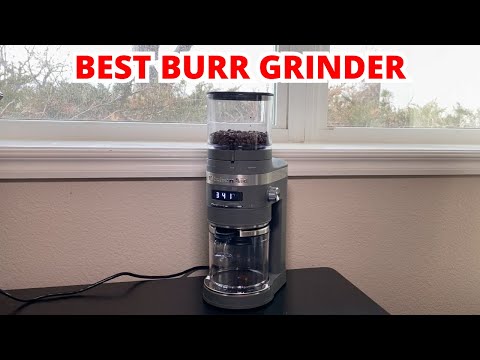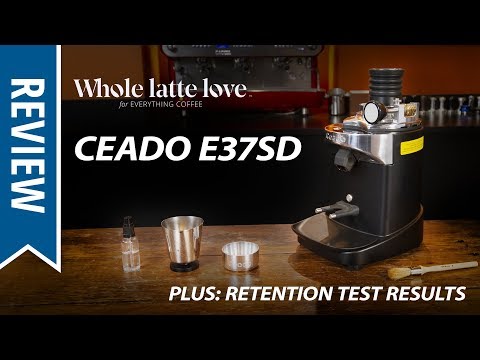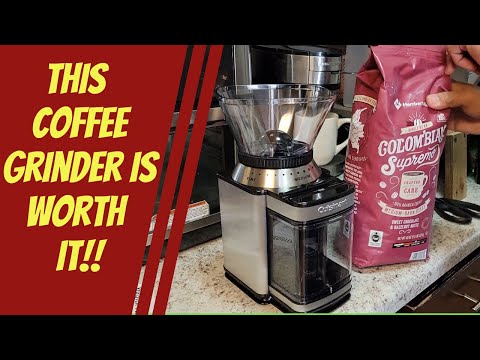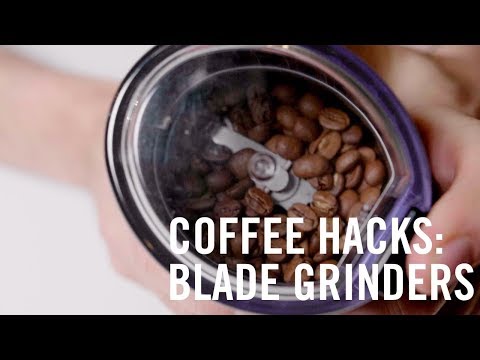Equipment Review: The Best Coffee Grinder and Our Testing Winners (Burr vs. Blade Coffee Grinders)
Coffee aficionados have long debated the best brewing method, but is the secret to great coffee all in the grind?
Buy Our Winning Burr Coffee Grinder: https://cooks.io/2BV2GZX
Buy Our Best Buy Burr Coffee Grinder: https://cooks.io/2EgaqYZ
Buy Our Winning Blade Coffee Grinder: https://cooks.io/2UnPHXP
Behind the Testing: https://cooks.io/2Uo3bDg
Full Testing Details and Ranking Chart: https://cooks.io/2G09BoD
Watch more equipment reviews: https://www.youtube.com/watch?v=KDfNwXXESiU&list=PLE720EF13D4C23DDC
Check our our Is it Bad? series: https://www.youtube.com/watch?v=lcg-auvLHlw&list=PLnbzopdwFrnYk4goXGnZqSCv6_EeR-8Vt
If you want the freshest, most full-flavored cup of coffee, we always recommend grinding your own coffee beans. It’s best to do this right before you brew, as our testing has shown that the beans begin to lose flavor and aroma within an hour of being ground.
Home coffee grinders come in two styles: blade and burr. A blade grinder works like a tiny food processor, with a rapidly spinning blade that chops coffee into smaller and smaller fragments. You have to hold the grind button down, time the grind, shake the grinder periodically to distribute the beans, and visually inspect the coffee to see if it’s reached the desired consistency.
A burr grinder, by contrast, operates like a pepper mill—it forces each bean to pass through a gap of a particular size. While a blade grinder has one chamber where you load, grind, and dispense the beans, a burr grinder consists of three components: a hopper where you feed in the beans, the grinding chamber, and a removable container that holds the grounds so you can transfer them to the coffee maker. You simply switch the machine on and whole beans are pulled from the hopper through two gear-like metal rings (called burrs) that spin against one another to crush the coffee. The setting you choose on the machine determines the space between the burrs and thus the size of the grind. Since each bean passes through the burrs and gets crushed only once, it’s a more precise process than using a blade grinder.
Burr grinders are the gold standard in the coffee industry, but now household brands such as Breville, Hamilton Beach, and KitchenAid are offering them for home users. To find out more about this popular grinding method, we tested 10 models priced from $29.86 to $199.99, all with metal burrs and at least eight grind settings, and compared them to our favorite blade grinder from Krups ($17.99).
Tasting the Difference: Is Grind Evenness Important?
But how much does grind evenness really affect your cup of coffee? To find out, we brewed three batches of coffee using the same beans ground in the most even burr grinder, the least even burr grinder, and our top-rated blade grinder, which achieved up to 46 percent medium pieces. We kept all the variables the same except for the grinder. A panel of 21 tasters then sampled the coffees in a blind tasting.
The verdict was surprising: Though we identified flavor differences in the batches of coffee, each made a good cup and tasters were split on which one they preferred. To verify these surprising results, we conducted this test three additional times. We also brought in coffee tasting experts, and they came to the same conclusion.
So if the evenness of your grind doesn’t matter all that much, why is the coffee industry so excited about burr grinders? With their range of settings and streamlined designs, which require the beans to pass through the grinder only once, burr grinders can guarantee consistency day after day in a way that blade grinders can’t. Ultimately, we think a good burr grinder is best for home brewing, too, since these machines are easy to use and take the guesswork out of grinding. And even though grind evenness isn’t the most important factor in how your coffee tastes, we also gave an edge to grinders that were more even, since they left no whole or partially processed beans in our grind (a waste of good coffee).
ABOUT US: Located in Boston’s Seaport District in the historic Innovation and Design Building, America's Test Kitchen features 15,000 square feet of kitchen space including multiple photography and video studios. It is the home of Cook’s Illustrated magazine and Cook’s Country magazine and is the workday destination for more than 60 test cooks, editors, and cookware specialists. Our mission is to test recipes over and over again until we understand how and why they work and until we arrive at the best version.
If you like us, follow us:
http://americastestkitchen.com
http://facebook.com/americastestkitchen
http://twitter.com/testkitchen
http://instagram.com/testkitchen
http://pinterest.com/testkitchen
Coffee aficionados have long debated the best brewing method, but is the secret to great coffee all in the grind?
Buy Our Winning Burr Coffee Grinder: https://cooks.io/2BV2GZX
Buy Our Best Buy Burr Coffee Grinder: https://cooks.io/2EgaqYZ
Buy Our Winning Blade Coffee Grinder: https://cooks.io/2UnPHXP
Behind the Testing: https://cooks.io/2Uo3bDg
Full Testing Details and Ranking Chart: https://cooks.io/2G09BoD
Watch more equipment reviews: https://www.youtube.com/watch?v=KDfNwXXESiU&list=PLE720EF13D4C23DDC
Check our our Is it Bad? series: https://www.youtube.com/watch?v=lcg-auvLHlw&list=PLnbzopdwFrnYk4goXGnZqSCv6_EeR-8Vt
If you want the freshest, most full-flavored cup of coffee, we always recommend grinding your own coffee beans. It’s best to do this right before you brew, as our testing has shown that the beans begin to lose flavor and aroma within an hour of being ground.
Home coffee grinders come in two styles: blade and burr. A blade grinder works like a tiny food processor, with a rapidly spinning blade that chops coffee into smaller and smaller fragments. You have to hold the grind button down, time the grind, shake the grinder periodically to distribute the beans, and visually inspect the coffee to see if it’s reached the desired consistency.
A burr grinder, by contrast, operates like a pepper mill—it forces each bean to pass through a gap of a particular size. While a blade grinder has one chamber where you load, grind, and dispense the beans, a burr grinder consists of three components: a hopper where you feed in the beans, the grinding chamber, and a removable container that holds the grounds so you can transfer them to the coffee maker. You simply switch the machine on and whole beans are pulled from the hopper through two gear-like metal rings (called burrs) that spin against one another to crush the coffee. The setting you choose on the machine determines the space between the burrs and thus the size of the grind. Since each bean passes through the burrs and gets crushed only once, it’s a more precise process than using a blade grinder.
Burr grinders are the gold standard in the coffee industry, but now household brands such as Breville, Hamilton Beach, and KitchenAid are offering them for home users. To find out more about this popular grinding method, we tested 10 models priced from $29.86 to $199.99, all with metal burrs and at least eight grind settings, and compared them to our favorite blade grinder from Krups ($17.99).
Tasting the Difference: Is Grind Evenness Important?
But how much does grind evenness really affect your cup of coffee? To find out, we brewed three batches of coffee using the same beans ground in the most even burr grinder, the least even burr grinder, and our top-rated blade grinder, which achieved up to 46 percent medium pieces. We kept all the variables the same except for the grinder. A panel of 21 tasters then sampled the coffees in a blind tasting.
The verdict was surprising: Though we identified flavor differences in the batches of coffee, each made a good cup and tasters were split on which one they preferred. To verify these surprising results, we conducted this test three additional times. We also brought in coffee tasting experts, and they came to the same conclusion.
So if the evenness of your grind doesn’t matter all that much, why is the coffee industry so excited about burr grinders? With their range of settings and streamlined designs, which require the beans to pass through the grinder only once, burr grinders can guarantee consistency day after day in a way that blade grinders can’t. Ultimately, we think a good burr grinder is best for home brewing, too, since these machines are easy to use and take the guesswork out of grinding. And even though grind evenness isn’t the most important factor in how your coffee tastes, we also gave an edge to grinders that were more even, since they left no whole or partially processed beans in our grind (a waste of good coffee).
ABOUT US: Located in Boston’s Seaport District in the historic Innovation and Design Building, America’s Test Kitchen features 15,000 square feet of kitchen space including multiple photography and video studios. It is the home of Cook’s Illustrated magazine and Cook’s Country magazine and is the workday destination for more than 60 test cooks, editors, and cookware specialists. Our mission is to test recipes over and over again until we understand how and why they work and until we arrive at the best version.
If you like us, follow us:
http://americastestkitchen.com
http://facebook.com/americastestkitchen
http://twitter.com/testkitchen
http://instagram.com/testkitchen
http://pinterest.com/testkitchen






![Cuisinart DBM-8 Supreme Grind Automatic Burr Mill [Coffee Grinder Review] Cuisinart DBM-8 Supreme Grind Automatic Burr Mill [Coffee Grinder Review]](https://automaticcoffeemaker.org/wp-content/uploads/2023/06/hqdefault-120.jpg)







Comments